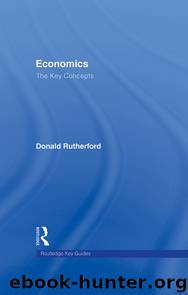Economics by Rutherford Donald

Author:Rutherford, Donald
Language: eng
Format: epub
Tags: Economics, Finance, Business & Industry
Publisher: Taylor & Francis
Published: 2007-05-24T16:00:00+00:00
Further reading:
Coddington 1976; Klein 1952; Laidler 1999; Leijonhufvud 1968; Patinkin 1956
LABOUR
The factor of production which cooperates with land and capital to produce goods and services. It is remunerated by wages and salaries in the case of employed labour, but by a hybrid income mixing wages and profits in the case of self-employment. Labour itself is conceptually similar to capital inasmuch as much of it embodies human capital, and like land in that much of it is scarce, earning economic rent.
The demand for labour is determined by the demand for its product. The supply of labour can be the supply of persons willing to work, the supply of hours or the supply of effort. The total supply of labour constitutes those employed, unemployed and self-employed, thus membership of the labour force depends on receiving wages or a salary or being engaged in job search activity. This supply depends on the growth in the population and the participation of that group in the labour market, hence reference is made to labour force participation (economic activity) rates.
The market for labour consists of employers and workers. It exists at the national level but also in local areas and occupations because of the heterogeneity of the labour supply. Labour markets can be difficult to clear and often are in a state of disequilibrium, as evidenced by the coexistence of unemployment and unfilled job vacancies. Poor clearing leads to frictional unemployment and is sometimes the result of high search costs. Governments subsidise the clearing of labour markets to reduce unemployment and increase output. The traditional way of doing this is to reduce labour market information deficiencies by setting up labour exchanges or job centres, with free advice on obtaining employment and a free notification of vacancies service for employers to use. Many labour markets are notorious for poor clearing. Workers can be very reluctant to move to another place, to retrain and to accept different working conditions. Employers can be slow or partial in advertising for the labour they need and have selection procedures which fail to obtain an optimal labour force. There can be interference in the setting of wages, as under incomes policies, so the wage level is kept below the market clearing price.
The interaction of employers demanding labour and workers supplying it determine wages and salaries. Labour costs are usually greater than the amounts paid in direct remuneration. The extra elements of cost include fringe benefits, such as pensions, and the expense of running collective facilities such as sports centres.
Wages come in different forms. At the macroeconomic level there is the wage rate, which is an average for the whole economy and is not specifically determined in non-planned economies but emerges as a statistical phenomenon. Given the segmented nature of the labour market, wage differentials abound. Cantillon and Smith suggested the principal reasons for occupations being paid differently. Wage differentials occur because of varying amounts of training, the pleasantness of the job, the degree of trust placed in the worker and the probability of success.
Download
This site does not store any files on its server. We only index and link to content provided by other sites. Please contact the content providers to delete copyright contents if any and email us, we'll remove relevant links or contents immediately.
International Integration of the Brazilian Economy by Elias C. Grivoyannis(90780)
The Radium Girls by Kate Moore(11921)
Turbulence by E. J. Noyes(7935)
Nudge - Improving Decisions about Health, Wealth, and Happiness by Thaler Sunstein(7615)
The Black Swan by Nassim Nicholas Taleb(7010)
Rich Dad Poor Dad by Robert T. Kiyosaki(6399)
Pioneering Portfolio Management by David F. Swensen(6226)
Man-made Catastrophes and Risk Information Concealment by Dmitry Chernov & Didier Sornette(5921)
Zero to One by Peter Thiel(5685)
Secrecy World by Jake Bernstein(4643)
Millionaire: The Philanderer, Gambler, and Duelist Who Invented Modern Finance by Janet Gleeson(4374)
The Age of Surveillance Capitalism by Shoshana Zuboff(4209)
Skin in the Game by Nassim Nicholas Taleb(4161)
Bullshit Jobs by David Graeber(4094)
The Money Culture by Michael Lewis(4075)
Skin in the Game: Hidden Asymmetries in Daily Life by Nassim Nicholas Taleb(3929)
The Dhandho Investor by Mohnish Pabrai(3698)
The Wisdom of Finance by Mihir Desai(3650)
Blockchain Basics by Daniel Drescher(3502)
